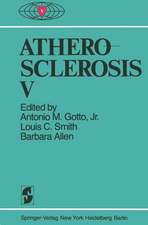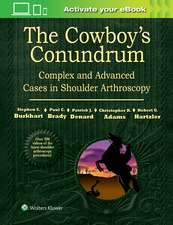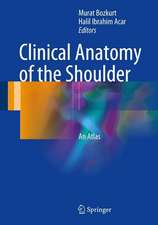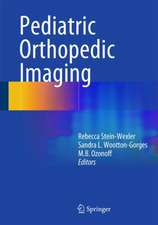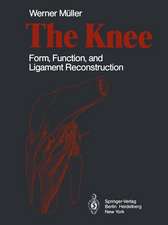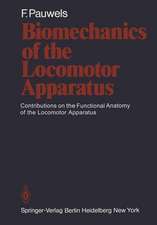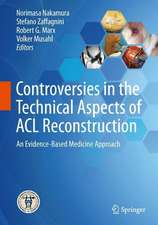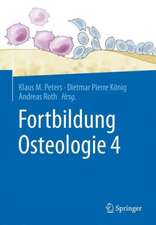Atherosclerosis VI: Proceedings of the Sixth International Symposium
Editat de F. G. Schettler, Antonio Gotto, G. Middelhoff, A. J. R. Habenicht, K. R. Jurutkaen Limba Engleză Paperback – 9 ian 2012
Preț: 415.72 lei
Preț vechi: 437.60 lei
-5% Nou
Puncte Express: 624
Preț estimativ în valută:
79.55€ • 83.05$ • 65.84£
79.55€ • 83.05$ • 65.84£
Carte tipărită la comandă
Livrare economică 04-18 aprilie
Preluare comenzi: 021 569.72.76
Specificații
ISBN-13: 9783642818196
ISBN-10: 3642818196
Pagini: 1016
Ilustrații: XXVIII, 982 p.
Dimensiuni: 170 x 244 x 53 mm
Greutate: 1.58 kg
Ediția:Softcover reprint of the original 1st ed. 1983
Editura: Springer Berlin, Heidelberg
Colecția Springer
Locul publicării:Berlin, Heidelberg, Germany
ISBN-10: 3642818196
Pagini: 1016
Ilustrații: XXVIII, 982 p.
Dimensiuni: 170 x 244 x 53 mm
Greutate: 1.58 kg
Ediția:Softcover reprint of the original 1st ed. 1983
Editura: Springer Berlin, Heidelberg
Colecția Springer
Locul publicării:Berlin, Heidelberg, Germany
Public țintă
ResearchDescriere
In 1982 Berlin was host for the second time to the International Symposium on Atherosclerosis. In 1973 the third symposium was held there, following the first in Athens -opened by the unforgettable Paul D. White -and the second in Chicago, where the great gentlemen of atherosclerosis research - Louis Katz and Irving Page - left their special imprint on the meeting. Since the third symposium in Berlin impressive advances have been made in the field of atherosclerosis. The symposia in Tokyo in 1976 and in Houston in 1979 introduced important new knowledge from current research, stimulating worldwide interest; Berlin highlighted the latest developments. The International Atherosclerosis Society (lAS) provides an international forum for the entire field of atherosclerosis research. Its main purpose is to apply the results of basic research to clinical medicine, and thereby to benefit the practitioner. Prevention and rehabilitation are of special importance. Intensified international cooperation is urgently needed at all levels. A declared goal of the lAS is contact between young investigators and between international research and work groups. Participating in the Berlin meeting were 1400 researchers from 42 nations. This illustrates the growing interest in atherosclerosis as the leading cause of death in "developed" societies. However, the incidence of atherosclerosis is increasing worldwide, although there are national differences in the pattern and appearance of the disease; this was documented at the Berlin Symposium.
Cuprins
1 Clinical Aspects of Atherosclerosis.- Atherosclerosis. The Major Problem in Man.- Clinical Aspects of Atherosclerosis—Recent Advances in Diagnosis and Evaluation of Coronary Heart Disease.- Recent Advances in Diagnosis and Evaluation. Peripheral Artery Disease.- Atherosclerosis. Recent Advances in Diagnosis and Evaluation – Cerebrovascular Disease.- Clinical Aspects of Atherosclerosis. Role of Coronary Artery Spasm.- Conservative Treatment of Coronary Heart Disease.- Conservative Treatment of Peripheral Artery Disease.- 1.1 Atherosclerosis in Childhood.- An Introduction to Atherosclerosis in Children.- Clinical and Anatomic Correlates of Cardiovascular Disease in Children from the Bogalusa Heart Study.- Dietary Prevention of Atherosclerosis in Childhood.- Early Indicators for the Risk of Atherogenesis. A. Field Test of a New Methodology on German and Japanese Kindergarten Children in Düsseldorf.- Morphologic Changes in Coronary Arteries of Children in Different Geographic Locations.- Structure and Ultrastructure of the Coronary Artery Intima in Children and Young Adults up to age 29.- The Natural History of Aortic Atherosclerosis in Children, Adolescents and Young Adults.- Immunohistology of Aortic Fatty Streaks in Children and Adults.- 1.2 Diseases of Lipid Metabolism.- Heterogeneity of Genetic Transmission of Familial Hypercholesterolemia F. H. from Direct Parents in 20 Families of Homozygotes Type IIa.- The Impact of Analbuminemia on Lipid Transport and Lipoproteins.- Familial Hypertriglyceridemia: Incidence, Genetics and Possible Defect in Cellular Metabolism.- Phytosterolemia.- Familial Chylomicronaemia due to a Circulating Inhibitor of Lipoprotein Lipase.- 1.3 Animal Models of Atherosclerosis.- Experimental Nonhuman Primate Atherosclerosis.- Platelets and Atherogenesis in Normal and von Willebrand Disease Pigs.- Lipid Accumulation in the Rabbit Aortic Wall in Response to Injury.- WHHL Rabbit, a Heritable Animal Model of Familial Hypercholesterolemia.- Hypertensive Rat Models of Atherosclerosis.- Seeking for More Similarity Between Animal Models and Human Atherosclerosis.- Lipoproteins, Blood Cells and Endothelial Integrity in Atherosclerosis: What Role for Eicosanoids?.- 1.4 Measurement and Identification of Atherosclerosis.- Chairman’s Comments on the Discussion at the Workshop on Measurement of Atherosclerosis.- Measurement of Regression in Atherosclerosis.- Measurement of Monotypism in Atherosclerosis.- Measurement of Human Atherosclerosis.- Identification of the Gelatinous Lesion.- Quantitation of Certain Qualitative Differences in the Atherosclerotic Process.- 1.5 Regression.- Chairman’s Introduction to Workshop on Regression.- Preliminary Report on Coronary Lesions and Serum Lipids Before and after 2 Years Dietary Intervention in 22 Patients.- Measurement of Atherosclerosis by Arteriography and Microdensitometry: Model and Clinical Investigations.- Role of Macrophages in Regression of Swine Atherosclerosis.- Potential for Atherosclerosis Regression in Perspective.- The Biochemical Basis for Anatomical Regression of Atherosclerosis.- The Endothelial Changes During Regression of Atherosclerotic Lesions in Animal Models.- 1.6 Diet.- Diet and Carcinogenesis.- Effects of Dietary Cholesterol and Saturated-Fat on the Appearance of HDLc in Peripheral and Cardiac Lymph.- Dietary Fibres for Prevention of CVD.- Dietary Cholesterol and Plasma Lipoproteins.- Experience with Soybean Protein Diets in Treating Hypercholesterolemias.- Dietary Fatty Acids as Prostaglandin Precursors.- Effects of Dietary Treatment on Lipoplitic Activities and Lipids and Apolipoproteins in Patients with Uremia.- 1.7 Exercise.- 6th International Symposium on Atherosclerosis. Introduction.- Therapeutical Effects of Endurance Training in Primary Hyperlipoproteinemia.- Atherosclerotic Disease in Non-Human Primates: Its Prevention and Regression by Moderate Conditioning Exercise.- The Effect of Different Types of Exercise on Serum Lipids.- Physical Exercise as Protection Against Heart Attack.- Exercise and Fibrinolysis.- Regulation of Serum Triglycerides in Trained Subjects.- Exercise and Arachidonic Metabolites: Effects of Adrenergic Beta Blockade.- Effect of Physical Training on Blood Pressure and Serum Lipoproteins in Middle-Aged Men with Borderline Hypertension.- 1.8 Drug Therapy of Hyperlipoproteinemias.- The Treatment of Hyperlipaemia by Gemfibrozil: a Comparison with Clofibrate.- Lipid-Lowering Agents and Apolipoproteins B, A-I, and A-II—a Longterm Study.- Compliance and Cholesterol-Lowering in Clinical Trials: Efficacy of Diet.- Long-Term Treatment of Hypercholesterolaemia with Guar Gum: Comparison with Probucol.- 1.9 Flow Restituting, Nonsurgical Intervention in Cardiovascular Disease.- Gross Endothelial Layer Blistering and Vascular Injury.- Haemodynamic Influences on Platelets in Haemostasis and Thrombosis.- Effect of Stresses on the Uptake of Material by the Arterial Wall.- Percutaneous Transluminal Angioplasty in the Treatment of Peripheral Vascular Disease.- Metabolic and Haemodynamic Effects of Plasma-Exchange in Familial Hypercholesterolemia.- 2 Arterial Wall and Plasma Components.- Role of Endothelial Dysfunction in Vivo in Smooth Muscle Proliferation.- Derivation and Progression of Atherosclerotic Plaques.- Hemodynamics as a Factor in Lesion Lacalization.- Role of Connective Tissue in the Arterio-Atherosclerotic Process. Interest of a Cell-Matrix Directed Pharmacology.- Arterial Wall Cells and Mitogens.- 2.1 Biology of Arterial Wall Cells.- The Microcarrier Co-Culture System: Interactions Between Endothelial and Smooth Muscle Cells in Vitro.- Intermediate Filaments of the Vascular Wall.- A Putative Mechanism for the Conversion of Aortic Smooth Muscle Cells into Foam Cells that Bypasses the Autoregulatory LDL Receptor-Mediated Process.- Structure and Function of Arterial Smooth Muscle Cells.- Alterde Growth Stimulation and LDL-Degradation in Human Arterial Smooth Muscle Cells ASMC and Fibroblasts F by Low Molecular Weight Serum Factors from Typre II Diabetics.- 2.2 Growth Factors and the Arterial Wall.- Platelet-Derived Growh Factors: Properties and Biologic Activities.- Preparation and Characterisation of Platelet-Derived Growth Factor.- Effects of PDGF and Endothelial Cell Products on Cellur Lipid and Lipoprotein Metabolism in Human Fibroblasts.- 2.3 HMG—Co A Reductase and Cell Metabolism.- Site of Action of LCAT in Plasma.- The Isolation and Partial Characterisation of two Lipid Transfer Proteins LTP-I and LTP-II, Each of which Facilitates the Transfer of Esterified Cholesterol, Triglyceride and Phospholipid Between Plasma Lipoproteins.- Besides Blockage of the Synthesis of HMG — Co A Reductase, Cycloheximide also Inhibits its Degradation.- Intestinal HMG-CoA Reductase: Regulation and Function.- 2.4 Phagocytosis in the Lesion.- Fluid-Phase Pinocytosis in Arterial Smooth Muscle Cells.- Interaction of Platelets, Macrophages and Lipoproteins in Relation to Atherogenesis.- Role of Macrophage Foam Cells in Arterial Lesions.- Chemotactic Responses of Monocyte-Macrophages. A Possible Mechanism for Their Migration into Atherosclerotic Lesions.- Macrophages in Coronary Artery and Aortic Intima and in Atherosclerotic Lesions of Children and Young Adults up to Age 29.- 3 Lipoproteins-An Overview.- Structure-Function Relationships in the Plasma Lipoproteins.- Metabolism of Triglyceride-Rich Lipoproteins.- Apolipoprotein E and Cholesterol Metabolism.- Selective Removal of Plasma Low-Density Lipoproteins by Combined Extracorporeal Plasma Separation-Immunoadsorption.- 3.1 Structural and Metabolic Aspects of Lipoproteins.- Apolipoprotein Mutants and Apolipoprotein Disorders.- Determination of Plasma Apolipoprotein Profiles.- The Plasma Cholesterol: Cholesterol-Ester Cycle.- Pathogenesis of Secondary Hyperlipoproteinemia.- Surface Organization of the Apolipoproteins of Plasma High Density Lipoproteins and Pelevance to Functions.- Receptor Interactions of Human Apolipoprotein.- Effects of Hormones on Plasma Lipoprotein Concentrations.- 3.2 Lipoprotein Receptors.- Monoclonal Antibody as a Probe for Structural and Functional Studies of the LDL Receptor.- The Role of Receptors in Apolipoprotein B Metabolism.- Factors Influencing Receptor-Mediated Low Density Lipoprotein Catabolism.- Rat and Human Lipoprotein Utilization by Cultured Rat Ovary Granulosa Cells.- 3.3 Regulation of Lipoprotein Synthesis and Secretion.- Contribution of Apoprotein B Production Rate in the Regulation of Lipoprotein Levels in Man.- Measurements of C Apoprotein Kinetics in Man.- Regulation of Rat Liver Apolipoprotein E mRNA and Cloning of its cDNA.- Effect of LP-X on Hepatic Cholesterol Synthesis.- 3.4 Apolipoproteins.- Apolipoprotein Research: A Multidisciplinary Task.- Significance of Apolipoproteins for the Biochemical Profile of Atherosclerosis.- Regulation of Lipoprotein Gene Expression.- Apolipoprotein AIV Metabolism in Man.- Mechanism of Action of Lipoprotein Lipase: Role of Apolipoprotein C-II.- Human Apolipoprotein Mutants.- 3.5 Lipolytic Enzymes.- Use of Specific Antibodies in the Study of the Function of Lipoprotein Lipase.- The Role of Hepatic Triglyceride Lipase in Primates.- Function of Hepatic Endothelial Lipase in Lipoprotein Metabolism.- Genetic Regulation of Lipoprotein Lipase.- Lipoprotein Lipase: Apolipoprotein C-II Interactions Studied by Fluorescence and Monoclonal Antibodies.- 4 Thrombosis.- Arachidonic Acid Metabolism in Human Platelets.- Factors Influencing the Growth, Stability and Fate of Arterial Thrombi.- Biosynthesis and Some Biological Properties of Prostaglandins and Leukotrienes.- Interactions Between Lipoproteins and PGI2 under Physiologic and Pathophysiologic Conditions.- 4.1 Platelet Aggregation and Phospholipid Metabolism.- Effects of Platelet-Derived Growth Factor on the Metabolism of Glycerolipids and Arachidonic Acid in Cultured Cells.- The Phosphatidylinositol Response and the Activation of Platelets.- Platelet Phospholipid Fatty Acids and Platelet Aggregation.- Regulatory Function of the Cellular Thiol-Disulfide Status in the Metabolic Control of Human Blood Platelet Aggregation.- 4.2 Prostanoids..- The Formation of Eicosanoids During Inflammation.- Prostaglandins, Cyclic Nucleotides and Atherosclerosis.- Prostacyclin Formation, Plasma Factor, Platelet Sensitivity and Prostacyclin Degradation in Coronary Heart Disease.- Vascular Resistance and Platelet Function on Cardiovascular Drugs and Diets Affecting Prostanoid Formation.- 5 Epidemiology and Prevention.- Coronary Heart Disease—Geographical Differences and Time Trends.- Coronary Disease Rist Factors: A Population View.- Pediatric Precursors of Atherosclerosis.- Intervention on Single Risk Factors: Hyperlipoproteinemia.- Intervention of Single Risk Factor: Hypertension.- Intervention of Single Risk Factors of Atherosclerosis: Thrombosis.- Intervention on Smoking: An Individual and Collective Challenge.- Multiple Risk Factor Intervention Trials.- Pharmacological Approach to the Prevention of Atherosclerosis.- 5.1 Epidemiology.- Role of Lipid Profiles in Assessing Atherogenesis.- Plasma Lipids and Lipoprotein Cholesterol Distributions and Correlates of HDL Cholesterol in Selected US and USSR Subpopulations US-USSR Steering Committee for Cardiovascular Area I: Pathogenesis of Atherosclerosis.- The Belgian Heart Disease Prevention Project: Six Years Coronary Risk Factors Evolution.- Peculiarities of Coronary Heart Disease in the French Population.- The Fate of the Patient with Opad Detected at an Early Stage.- Population Attributable Events—Implications for Prevention.- Risk Factors in Insulin Dependent Diabetics.- Contribution to the Discussion.- Cardiovascular Epidemiology and Preventive Community Programmes in Austria.- 5.2 Hypocholesterolemia- A Risk Factor?.- Clinical Associations of Hypocholesterolaemia.- On a Possible Inverse Relationship Between Plasma Cholesterol and the Risk of Cancer. The Framingham Study.- Cholesterol and Steroid Hormone Metabolism in Abetalipoproteinemia.- Associations Between Plasma Cholesterol, Cell Membrane Composition and Fluidity, and Retinoid Concentrations in a Normal Male Population.- The Prognostic Significance of Hypocholesterolemia in Hospitalized Patients.- The Association of Low Serum Cholesterol Level to the Risk of Cancer. Significance with Respect to Dietary Modification for Coronary Heart Disease Prevention.- Serum Cholesterol and Cancer Mortality in White Males: Social Class Effects, Evans County Twenty Year Foliow-Up Study.- 5.3 Smoking and Atherosclerosis.- Carbon Monoxide and Atherosclerosis.- The Influence of Smoking on Plasmalipoproteins.- Smoking and Atherosclerotic Disease. The Oslo Study.- Epidemiology of Cardiovascular Disease in Different Countries in Relation to Smoking.- Smoking and Atherosclerosis: Risk Factor Reduction.- Nicotine and Atherosclerosis.- Smoking: A Paediatric Disease.- Smoking and Lipid Metabolism.- The Influence of Smoking on Systolic and Diastolic Blood Pressure.- 5.4 Serum Lipid Lowering in Secondary Prevention.- Current Japanese Situations on Secondary Prevention and Lipid Lowering Drugs.- Serum Lipid Lowering ind Secondary Prevention: A Review.- A Controlled Trial of Substantial Reduction of Plasma Lipids in Symptomatic Atherosclerosis: An Angiographic Study.- Program on the Surgical Control of the Hyperlipidemias Posch. A Secondary Intervention Trial-4-Year Lipid Results.- Platelet-Vessel Wall Interactions in Human and Experimental Hypercholesterolemia.- Secondary Prevention of Ischaemic Heart Disease by the Combined Treatment with Clofibrate and Nicotinic Acid.- 6 Risks of Obesity.- Diabetes Mellitus and Obesity.- Hypertension in Obesity.- Surgical Risks in Obese Patients.- Obesity and Lipoprotein Metabolism.- Another Look at Body Weight, Health and Longevity.- 6.1 Addendum.- Status of a Computerized, Angiographic Regression Trial CLAS.


